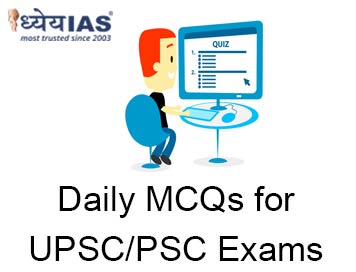Home > Daily-mcqs
Daily-mcqs 20 Nov 2025

Q1:
With reference to beneficiary lists under the National Food Security Act (NFSA), consider the following statements: 1. Deletion of ineligible beneficiaries under NFSA can only be carried out by the Central Government because the Centre manages overall procurement and distribution. 2. One of the major categories of ineligible beneficiaries removed recently includes individuals flagged through central databases but deleted only after state-level verification. 3. The ongoing Free Monthly Ration Scheme under NFSA provides 5 kg of free food grains per person per month under Priority Households. How many of the above statements are correct?
A: Only one
B: Only two
C: All three
D: None
Answer: B
Explanation:
Statement 1 – Incorrect.
While the Centre procures and allocates food grains, states are responsible for identifying beneficiaries, issuing ration cards, and deleting ineligible names. Hence deletion cannot be done solely by the Centre.
Statement 2 – Correct.
The Centre shared lists generated from central databases (e.g., asset/income flags, deceased persons), but names were deleted only after state-level field verification, ensuring federal coordination.
Statement 3 – Correct.
The ongoing Free Monthly Ration Scheme makes NFSA allocations free of cost, and PHH individuals get 5 kg/person/month.
Q2:
Consider the following regarding the National Food Security Act (NFSA), 2013: 1. NFSA coverage is based on Census 2011, under which 75% of rural and 50% of urban population are entitled to be covered. 2. Under Antyodaya Anna Yojana (AAY), each member of a household is entitled to 35 kg of food grains per month. 3. One of the concerns raised about recent deletions is the possibility of wrongful exclusion of households lacking proper documentation or living in remote regions. Which of the above statements is/are correct?
A: 1 and 2 only
B: 1 and 3 only
C: 2 and 3 only
D: 1, 2, and 3
Answer: B
Explanation:
Statement 1 – Correct.
NFSA explicitly uses Census 2011 population figures to determine coverage—75% rural and 50% urban, totaling about 813.5 million people.
Statement 2 – Incorrect.
Under AAY, the entitlement is 35 kg per family, not per individual. It is a family-wise allocation irrespective of family size.
Statement 3 – Correct.
Experts and activists have highlighted concerns about wrongful exclusion, particularly among tribal communities, migrants, and households lacking documentation, especially during large-scale deletions.
Q3:
With reference to India’s dugong populations, consider the following statements: 1. Dugongs are listed as Endangered on the IUCN Red List and protected under Schedule II of the Wildlife Protection Act, 1972. 2. Fishing bycatch is among the major causes of dugong mortality in areas such as Tamil Nadu, Andaman & Nicobar Islands, and the Gulf of Kutch. 3. Dugongs play a key ecological role by maintaining healthy seagrass ecosystems that act as significant carbon sinks. How many of the above statements are correct?
A: Only one
B: Only two
C: All three
D: None
Answer: B
Explanation:
Statement 1 – Incorrect.
Dugongs are listed as Vulnerable on the IUCN Red List, not Endangered.
In India, they are protected under Schedule I, not Schedule II, of the Wildlife (Protection) Act, 1972.
Statement 2 – Correct.
Fishing bycatch, especially entanglement in gillnets, is a major cause of dugong deaths in Tamil Nadu, A&N Islands, and the Gulf of Kutch.
Statement 3 – Correct.
Dugongs are ecosystem engineers. Their grazing maintains healthy seagrass meadows, prevents decay, and enhances carbon sequestration, making them crucial for climate mitigation.
Q4:
With reference to the recent expansion of the Pradhan Mantri Fasal Bima Yojana (PMFBY), consider the following statements: 1. Wild animal attacks have been included as the fifth add-on under the category of localised risks in PMFBY. 2. Paddy inundation was removed from PMFBY in 2018 due to difficulties in damage assessment but has now been reintroduced as a localised calamity cover. 3. For reporting crop losses under the new provisions, farmers must submit claims within 24 hours through the PMFBY mobile app with geotagged photographs. How many of the above statements are correct?
A: Only one
B: Only two
C: All three
D: None
Answer: B
Explanation:
Statement 1 – Correct.
Wild animal attacks are now included as the fifth add-on under the localised risk category. States will identify the specific animals and vulnerable districts based on historical patterns.
Statement 2 – Correct.
Paddy inundation was earlier discontinued in 2018 due to assessment challenges. It has now been reintroduced as a localised calamity cover, especially benefiting flood-prone and coastal states.
Statement 3 – Incorrect.
Farmers must report losses within 72 hours, not 24 hours, and must upload geotagged photos through the mobile app.
Q5:
With reference to the QS World University Rankings for Sustainability 2026, consider the following statements: 1. The rankings evaluate universities across environmental, social, and governance dimensions. 2. India has the third-highest number of universities featured in the 2026 edition. 3. IIT Delhi emerged as India’s best performer, ranking in the top 150 globally. How many of the above statements are correct?
A: Only one
B: Only two
C: All three
D: None
Answer: A
Explanation:
Statement 1 – Correct.
The QS Sustainability Rankings assess institutions across three pillars:
Environmental Sustainability, Social Sustainability, and Governance & Institutional Strategy.
Statement 2 – Incorrect.
India ranks fourth, not third, in institutional representation—after the U.S., China, and the U.K..
Statement 3 – Incorrect.
IIT Delhi is India’s top performer but is ranked around 205th, not within the top 150.